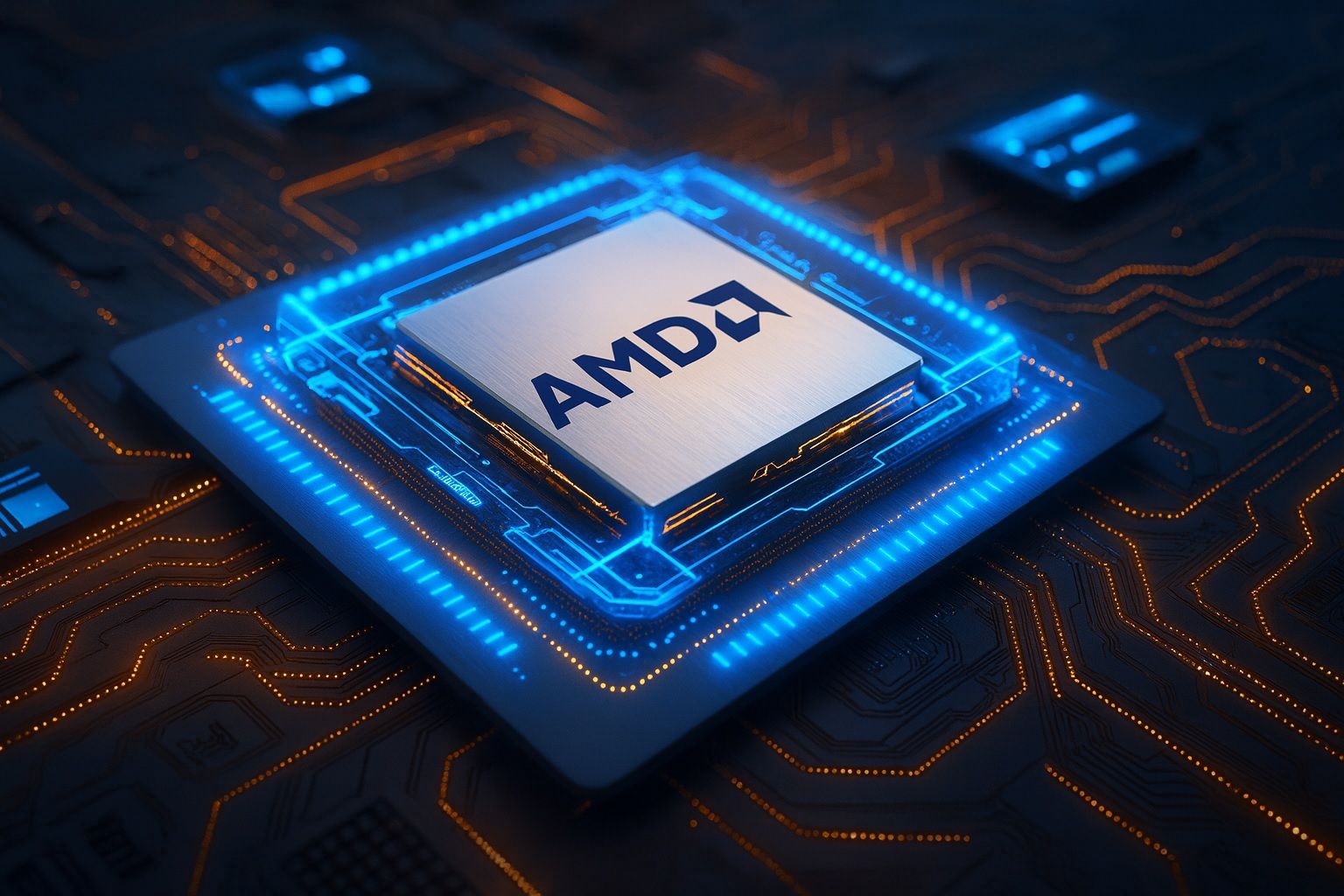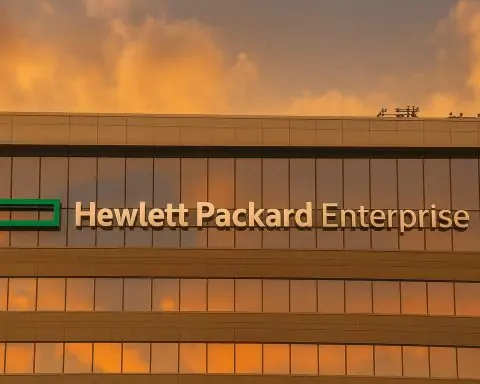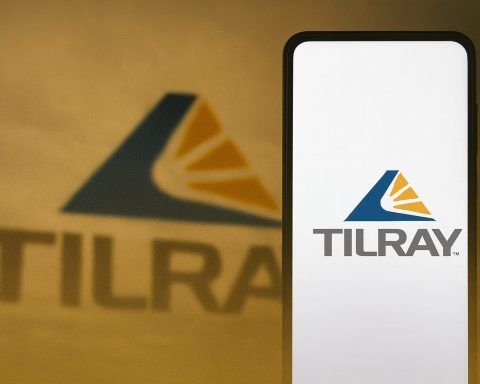- Price & Performance (Oct 14, 2025): AMD trades around $217 on Oct 14 (market open) [1], having recently hit ~$235 intraday after surging on AI news. Shares are up roughly 70–90% YTD [2], far outperforming peers (Nvidia ~+40% YTD [3]). Market cap is about $353 billion [4] (3rd largest chipmaker globally [5]).
- Major News (Oct 2025): On Oct 6, 2025 AMD announced a blockbuster 6‑gigawatt GPU deal with OpenAI (AI chips plus warrants for ~10% stake) [6] [7]. This deal was called “transformative for the industry” and sent AMD stock up ~30–34% that day [8] [9]. On Oct 14, AMD expanded its AI footprint by partnering with Oracle: Oracle will deploy 50,000 of AMD’s next-gen MI450 GPUs in 2026 [10] [11], lifting AMD shares ~3% amid a broader market dip [12].
- Financials (Recent Quarter): In Q2 2025, AMD reported a record $7.7 billion revenue (+32% YoY) [13]. GAAP EPS was $0.54 (non-GAAP $0.48) [14]. Demand for EPYC server CPUs and Ryzen PC chips drove growth, while AI accelerators added early revenue [15]. Margins fell (GAAP gross margin ~40%) due to heavy R&D spend and an $800M inventory charge on AI chips [16]. CFO Jean Hu noted “record free cash flow” and 32% revenue growth [17]. AMD guided Q3 revenue ~ $8.7 B (≈+21% YoY), implying ~$33 B for FY2025 [18].
- Valuation & Analysts: AMD’s trailing P/E is roughly 125× [19]. Consensus is moderately bullish – about 60–65% of analysts rate AMD a Buy [20]. Price targets cluster in the $200–$300 range: Jefferies lifted its target to $300 (Buy) [21], UBS to $210, HSBC $200 [22]. The Street’s 12‑month consensus is about $207 [23]. However, skeptics note valuation is rich (~90× forward EPS) [24]. Some warn there’s “little room for error” if growth slows [25]; Goldman Sachs still has a cautious sub-$150 target [26].
- Competition: AMD is now the #3 chipmaker by market cap (~$300B) [27]. It competes with Nvidia (AI GPUs) and Intel (CPUs). Nvidia dominates ~94% of AI GPU sales [28], while AMD is positioning as an “open” alternative with its Instinct MI300X/MI350X accelerators. In CPUs, AMD’s EPYC has captured >25% of the server market [29], cutting into Intel’s base. Nvidia and Intel have struck deals (Nvidia invested $5B in Intel) [30], but AMD continues to erode Intel share and push into AI racks with its new “Helios” designs [31] [32].
- Sentiment & Ownership: Short interest in AMD is modest (≈2.6% of float; days-to-cover ~0.8) [33]. However, short interest rose ~7% recently, hinting some growing bearish bets. Insiders have been net sellers (~$45M sold in past 3 months, with no buys) [34]. Institutions own ~71% of AMD stock [35], indicating strong institutional backing. News sentiment and coverage are high (AI deals have drawn intense media attention).
Market Performance & Stock Data
In October 2025, AMD shares have been volatile but strong. As of Oct 14 opening, AMD traded around $217 [36], slightly off its recent peak (~$235 reached after the Oct 6 OpenAI deal). The stock is up roughly 80% year-to-date [37], driven by booming demand for AI chips and data-center hardware. (For context, the broader Nasdaq is up ~10% YTD and rival Nvidia around +40% [38].) AMD’s market capitalization is now about $350–$360 billion [39], making it the world’s third-largest chipmaker. Trading volumes have surged during news events, and the stock’s 52-week range has widened (roughly $76–$240 [40]). In mid-October, AMD’s beta (~1.9) reflects its high sensitivity to tech market swings.
Recent News & Catalysts (Oct 2025)
AMD has been at the center of industry news. October 6, 2025 – AMD announced a multi-year AI partnership with OpenAI: it will supply 6 gigawatts of cutting-edge Instinct GPUs for OpenAI’s data centers [41] [42]. The deal gives OpenAI warrants to acquire up to ~10% of AMD for a nominal price [43] [44]. AMD executives billed this as an industry-defining pact. Indeed, on Oct 6 the stock surged 30–34%, its biggest one-day gain since 2016 [45] [46]. AMD EVP Forrest Norrod told Reuters the deal is “certainly transformative…for the industry” [47]. AMD’s CEO Lisa Su similarly praised it as a “win-win…enabling the world’s most ambitious AI buildout” [48].
October 14, 2025 – Oracle Technologies announced it will deploy AMD’s upcoming MI450 AI chips in its cloud. Oracle plans to install 50,000 MI450 processors in 2026 (with more in 2027) to power AI workloads [49]. This expanded partnership (coming days after OpenAI’s deal) gave AMD another marquee client. On Oct 14 pre-market, AMD stock jumped ~3% on the Oracle news [50]. Reuters noted the collaboration lets Oracle “expand its processor offerings…as businesses rush to secure compute capacity” [51].
In industry context, AMD’s news comes amid major moves by rivals: Nvidia recently invested $5 billion in Intel’s stock [52], and Oracle itself is reportedly locking in vast AI compute with various partners. Still, AMD’s string of AI-oriented announcements has captured investor attention and defined the Oct rally. Over the first two weeks of Oct, AMD leapt roughly 29% driven by these AI deal announcements [53].
Financial Results & Metrics
AMD’s fundamentals have strengthened, especially in AI and data-center markets. In Q2 2025 (ending Jun 28), AMD reported $7.685 billion revenue, a 32% jump year-over-year [54]. GAAP net income was $872 M (vs $265 M a year earlier), yielding $0.54 EPS [55]. On a non-GAAP basis (excluding stock comps and charges) EPS was $0.48. Growth was broad-based: Data Center sales hit $3.2B (+14% YoY) on strong EPYC CPU demand [56], while Client/Gaming sales soared to $3.6B (+69% YoY) driven by Ryzen CPUs and Radeon GPUs [57]. Despite robust sales, gross margin compressed (GAAP margin ~40%, down ~9 points from year-ago [58]). AMD explained the margin pressure was due in part to heavy R&D spending and a ~$800 M inventory charge for new AI GPUs [59] [60].
Management was upbeat: CEO Lisa Su said Q2 saw “strong revenue growth…led by record server and PC processor sales” and that AMD is “well positioned to deliver significant growth” in H2 2025 [61]. CFO Jean Hu highlighted “record free cash flow” and 32% revenue growth [62]. AMD issued Q3 2025 guidance around $8.7 billion, implying another +20%+ YoY gain [63]. That suggests full-year 2025 revenue of ~$33 billion (versus $23.6 B in 2024) [64].
Key financial metrics (trailing-12-month) reflect rapid growth: revenue ~$29.6 B, net income ~$2.8 B, EPS ~$1.73 [65]. This translates to a trailing P/E around 125× [66] – high by historical standards, reflecting expectations of strong future growth. (By comparison, the S&P 500’s average P/E is roughly 20–30×.) AMD pays no dividend. Its balance sheet remains solid, and free cash flow has turned positive thanks to higher earnings.
Analyst Opinions & Forecasts
Wall Street’s view has trended positive. According to aggregated data, ~60–65% of analysts rate AMD as a Buy [67]. The consensus 12‑month price target is about $207 [68] (slightly below current levels). However, many firms have lifted targets in light of the AI deals. For example, Jefferies upgraded AMD to Buy with a $300 target [69] (a Street-high), while UBS bumped its target to $210 and HSBC to $200 [70] [71]. Even so, some cautious analysts note the stock now trades at roughly 90× forward earnings, implying lofty expectations [72] [73]. They warn there’s “little room for error” if growth misses forecasts [74].
Quotes from experts highlight mixed sentiment: Concurrent Asset Management’s Leah Bennett said AMD’s partnership with OpenAI “helps validate their technology” but noted AMD has long trailed Nvidia [75]. Breakingviews columnist Robert Cyran quipped that OpenAI turned to “second-choice AMD” for its chip order, reflecting how wild AI spending is reshaping supplier dynamics [76]. On balance, analysts project continued revenue acceleration driven by data-center AI demand. Many forecasts peg FY2026 revenue well above $40 B if AMD captures a slice of the AI market. However, even bullish forecasts assume nearly flawless execution and favorable market conditions.
Competitive Landscape
AMD now faces a two-front battle. In GPUs/AI accelerators, Nvidia is overwhelmingly dominant (~94% share of data-center GPUs [77]). Nvidia even sells complete AI systems (DGX/Hopper servers), and recently hit a ~$4 trillion valuation on soaring demand. AMD is challenging this with its open-software approach: its new Instinct MI300X/MI350X (and upcoming MI450) GPUs aim to rival Nvidia’s Blackwell chips on performance and cost. AMD is also developing integrated “rack-scale” solutions: its Helios rack (MI400 GPUs + EPYC CPUs + Pensando NICs) [78] is intended to compete with Nvidia’s full-stack offerings.
In CPUs, AMD is chipping away at Intel’s empire. AMD’s Zen‑based EPYC chips now hold over 25% of the server CPU market [79]. AMD has won contracts with hyperscalers (Meta, Microsoft, etc.) and even Intel is reportedly in talks to become a foundry for AMD products. Intel, buoyed by a $9 billion U.S. government stake and a $5 billion investment from Nvidia, is refocusing on AI and GPU efforts [80]. Still, Intel’s current share position in key markets gives AMD a powerful growth runway.
Overall, AMD is firmly the #2 player in many segments. It holds maybe 20–30% of GPU and CPU markets (versus ~70–80% for leader Nvidia/Intel). Industry experts note AMD’s remarkable comeback under CEO Lisa Su – from near bankruptcy in 2012 to tech heavyweight – is “one of the most dramatic turnarounds in tech” [81]. The new AI deals suggest AMD could continue eroding rivals’ leads, but Nvidia’s sheer scale means AMD remains a challenger, not yet a co-equal, in high-end AI compute.
Investor Sentiment & Ownership
Retail and institutional interest in AMD is high. News sentiment on AMD has been very positive (many outlets highlight its AI push), and search and social engagement spiked after the OpenAI announcement. On MarketBeat data, news sentiment is above average [82], and market followers have jumped 100% in recent weeks. Hedge funds and institutions own the lion’s share of shares (≈71% institutional ownership [83]). Insider activity is minimal but tells a story: in the past 3 months AMD insiders only sold stock (~$45 M worth) [84]. No insider buys were reported, and only about 0.06% of shares are held by insiders, which is very low. Short sellers hold a small portion (~2.6% of float) [85] – days-to-cover is just 0.8, so a short squeeze risk is modest. Interestingly, short interest has ticked up ~6–7% recently [86], perhaps as some investors question the stock’s lofty valuation.
Overall, the market sentiment is bullish but cautious. Analysts and the media broadly cheer AMD’s AI wins, yet many point out that with the stock trading near all-time highs, any hiccup (e.g. slower chip ramp, geopolitical export issues, or renewed macro weakness) could trigger a pullback.
Outlook
Looking ahead, AMD’s path depends on AI market adoption and competitive execution. The OpenAI and Oracle deals secure large future orders (OpenAI is even building a 1‑gigawatt AMD-powered facility [87]), which could translate to “tens of billions” in annual revenue [88]. If AMD’s MI450 and MI300X series perform as hoped, AMD may capture new data-center market share. Analysts now anticipate robust growth: most models predict double-digit revenue and earnings growth through 2026, with potential for further analyst upgrades.
However, some caution is warranted. AMD’s recent surge means much of the good news is already priced in: the stock trades at ~90× forward earnings [89]. To justify that, AMD must deliver near-flawless execution in product ramps and supply. If broader market conditions sour (e.g. global chip demand weakness or worsening U.S.-China tech frictions), AMD could come under pressure along with all tech stocks. Insiders’ selling and any signs of slowing growth could fuel profit-taking.
In summary, AMD is riding a wave of AI-driven optimism. Its stock report as of Oct 14, 2025 shows strong recent performance and bullish analyst sentiment, backed by record revenues and marquee partnerships [90] [91]. The biggest question is sustainability: can AMD expand beyond a high-flying AI story into long-term dominance? For now, Wall Street sees significant upside (some targets near $300 [92] [93]), but most agree the stock’s fate hinges on execution. As one analyst put it, AMD’s rapid rise has been welcome, but at a valuation that “leaves little room for error” if expectations slip [94].
Sources: Official AMD filings and press releases [95] [96]; recent news from Reuters, CNBC, etc. [97] [98]; financial data and analyst surveys from MarketBeat, StockAnalysis, TS2.Tech [99] [100]. These and other citations document the facts above.
References
1. stockanalysis.com, 2. ts2.tech, 3. ts2.tech, 4. stockanalysis.com, 5. ts2.tech, 6. ts2.tech, 7. ir.amd.com, 8. ts2.tech, 9. www.reuters.com, 10. www.reuters.com, 11. www.reuters.com, 12. www.reuters.com, 13. ir.amd.com, 14. ir.amd.com, 15. ir.amd.com, 16. ir.amd.com, 17. ir.amd.com, 18. ts2.tech, 19. stockanalysis.com, 20. ts2.tech, 21. ts2.tech, 22. ts2.tech, 23. stockanalysis.com, 24. ts2.tech, 25. www.ainvest.com, 26. ts2.tech, 27. ts2.tech, 28. ts2.tech, 29. ts2.tech, 30. ts2.tech, 31. ir.amd.com, 32. ts2.tech, 33. www.marketbeat.com, 34. www.marketbeat.com, 35. www.marketbeat.com, 36. stockanalysis.com, 37. ts2.tech, 38. ts2.tech, 39. stockanalysis.com, 40. stockanalysis.com, 41. ts2.tech, 42. ir.amd.com, 43. ts2.tech, 44. www.reuters.com, 45. ts2.tech, 46. www.reuters.com, 47. www.reuters.com, 48. ir.amd.com, 49. www.reuters.com, 50. www.reuters.com, 51. www.reuters.com, 52. ts2.tech, 53. ts2.tech, 54. ir.amd.com, 55. ir.amd.com, 56. ir.amd.com, 57. ir.amd.com, 58. ir.amd.com, 59. ir.amd.com, 60. ir.amd.com, 61. ir.amd.com, 62. ir.amd.com, 63. ts2.tech, 64. ts2.tech, 65. stockanalysis.com, 66. stockanalysis.com, 67. ts2.tech, 68. stockanalysis.com, 69. ts2.tech, 70. ts2.tech, 71. www.ainvest.com, 72. ts2.tech, 73. www.ainvest.com, 74. www.ainvest.com, 75. www.reuters.com, 76. www.reuters.com, 77. ts2.tech, 78. ir.amd.com, 79. ts2.tech, 80. ts2.tech, 81. www.ainvest.com, 82. www.marketbeat.com, 83. www.marketbeat.com, 84. www.marketbeat.com, 85. www.marketbeat.com, 86. www.marketbeat.com, 87. www.reuters.com, 88. www.reuters.com, 89. ts2.tech, 90. ir.amd.com, 91. ir.amd.com, 92. ts2.tech, 93. www.ainvest.com, 94. www.ainvest.com, 95. ir.amd.com, 96. ir.amd.com, 97. www.reuters.com, 98. www.reuters.com, 99. stockanalysis.com, 100. ts2.tech







